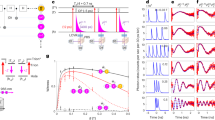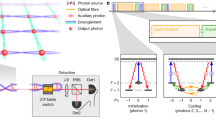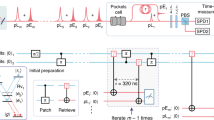Abstract
Quantum information science attempts to exploit capabilities from the quantum realm to accomplish tasks that are otherwise impossible in the classical domain1. Although sufficient conditions have been formulated for the physical resources required to achieve quantum computation and communication2, there is a growing understanding of the power of quantum measurement combined with the conditional evolution of quantum states for accomplishing diverse tasks in quantum information science3,4,5. For example, a protocol has recently been developed6 for the realization of scalable long-distance quantum communication and the distribution of entanglement over quantum networks. Here we report the first enabling step in the realization of this protocol, namely the observation of quantum correlations for photon pairs generated in the collective emission from an atomic ensemble. The nonclassical character of the fields is demonstrated by the violation of an inequality involving their normalized correlation functions. Compared to previous investigations of non-classical correlations for photon pairs produced in atomic cascades7 and in parametric down-conversion8, our experiment is distinct in that the correlated photons are separated by a programmable time interval (of about 400 nanoseconds in our initial experiments).
This is a preview of subscription content, access via your institution
Access options
Subscribe to this journal
Receive 51 print issues and online access
$199.00 per year
only $3.90 per issue
Buy this article
- Purchase on Springer Link
- Instant access to full article PDF
Prices may be subject to local taxes which are calculated during checkout



Similar content being viewed by others
References
Preskill, J. P. Quantum Computation Lecture Notes for Physics 219/Computer Science 219 〈http://www.theory.caltech.edu/people/preskill/ph229/〉.
DiVincenzo, D. P. The physical implementation of quantum computation. Fortsch. Phys. 48, 771–783 (2000)
Bose, S., Knight, P. L., Plenio, M. B. & Vedral, V. Proposal for teleportation of an atomic state via cavity decay. Phys. Rev. Lett. 83, 5158–5161 (1999)
Knill, E., Laflamme, R. & Milburn, G. J. A scheme for efficient quantum computation with linear optics. Nature 409, 46–52 (2001)
Raussendorf, R. & Briegel, H. J. A one-way quantum computer. Phys. Rev. Lett. 86, 5188–5191 (2001)
Duan, L.-M., Lukin, M., Cirac, J. I. & Zoller, P. Long-distance quantum communication with atomic ensembles and linear optics. Nature 414, 413–418 (2001)
Clauser, J. F. Experimental distinction between the quantum and classical field-theoretic predictions for the photoelectric effect. Phys. Rev. D 9, 853–860 (1974)
Mandel, L. Quantum effects in one-photon and two-photon interference. Rev. Mod. Phys. 71(2), S274–S282 (1999)
Briegel, H.-J., Duer, W., Cirac, J. I. & Zoller, P. Quantum repeaters: The role of imperfect local operations in quantum communication. Phys. Rev. Lett. 81, 5932–5935 (1999)
Enk, S. J., Cirac, J. I. & Zoller, P. Photonic channels for quantum communication. Science 279, 205–208 (1998)
Duan, L.-M. Entangling many atomic ensembles with laser manipulation. Phys. Rev. Lett. 88, 170402–170405 (2002)
Metcalf, H. J. & van der Straten, P. Laser Cooling and Trapping (Springer, 1999)
Kitagawa, M. & Ueda, M. Nonlinear-interferometric generation of number-phase correlated fermion states. Phys. Rev. Lett. 67, 1852–1854 (1991)
Wineland, D. J., Bollinger, J. J., Itano, W. M. & Moore, F. L. Spin squeezing and reduced quantum noise in spectroscopy. Phys. Rev. A 46, R6797–R6800 (1992)
Kuzmich, A., Mølmer, K. & Polzik, E. S. Spin squeezing in an ensemble of atoms illuminated with squeezed light. Phys. Rev. Lett. 79, 4782–4785 (1997)
Kuzmich, A., Bigelow, N. P. & Mandel, L. Atomic quantum non-demolition measurements and squeezing. Europhys. Lett. A 42, 481–486 (1998)
Mølmer, K. Twin-correlations in atoms. Eur. Phys. J. D 5, 301–305 (1999)
Hald, J., Sørensen, J. L., Schori, C. & Polzik, E. S. Spin squeezed atoms: A macroscopic entangled ensemble created by light. Phys. Rev. Lett. 83, 1319–1320 (1999)
Kuzmich, A., Mandel, L. & Bigelow, N. P. Generation of spin squeezing via continuous quantum non-demolition measurements. Phys. Rev. Lett. 85, 1594–1597 (2000)
Julsgaard, B., Kozhekin, A. & Polzik, E. S. Experimental long-lived entanglement of two macroscopic objects. Nature 413, 400–403 (2001)
Duan, L.-M., Cirac, J. I. & Zoller, P. Three-dimensional theory for interaction between atomic ensembles and free-space light. Phys. Rev. A. 66, 023818 (2002)
Fleischhauer, M. & Lukin, M. D. Dark-state polaritons in electromagnetically induced transparency. Phys. Rev. Lett. 84, 5094–5097 (2000)
Harris, S. E. & Hau, L. V. Nonlinear optics at low light levels. Phys. Rev. Lett. 82, 4611–4614 (1999)
Zibrov, A. S. et al. Transporting and time reversing light via atomic coherence. Phys. Rev. Lett. 88, 103601 (2002)
Mandel, L. & Wolf, E. Optical Coherence and Quantum Optics (Cambridge Univ. Press, Cambridge, UK, 1995)
Schori, C., Julsgaard, B., Sørensen, J. L. & Polzik, E. S. Recording quantum properties of light in a long-lived atomic spin state: Towards quantum memory. Phys. Rev. Lett. 89, 057903 (2002)
Pelton, M. et al. Efficient source of single photons: A single dot in a micropost microcavity. Phys. Rev. Lett. 89, 233602 (2002)
Alexandrov, E. B., Balabas, M. V., Pasgalev, A. S., Verkhovskii, A. K. & Yakobson, N. N. Double-resonance atomic magnetometers: from gas discharge to laser pumping. Laser Phys. 6, 244–251 (1996)
van der Wal, C. H. et al. Atomic memory for correlated photon states. Science, published online 22 May 2003 (doi:10.1126/science.1085946).
Acknowledgements
H.J.K. gratefully acknowledges interactions with M. D. Lukin about various aspects of the experiment. This work was supported by the National Science Foundation, by the Caltech MURI Center for Quantum Networks, and by the Office of Naval Research.
Author information
Authors and Affiliations
Corresponding author
Ethics declarations
Competing interests
The authors declare that they have no competing financial interests.
Supplementary information
Rights and permissions
About this article
Cite this article
Kuzmich, A., Bowen, W., Boozer, A. et al. Generation of nonclassical photon pairs for scalable quantum communication with atomic ensembles. Nature 423, 731–734 (2003). https://doi.org/10.1038/nature01714
Received:
Accepted:
Issue Date:
DOI: https://doi.org/10.1038/nature01714
This article is cited by
-
Non-classical microwave–optical photon pair generation with a chip-scale transducer
Nature Physics (2024)
-
Entangling motional atoms and an optical loop at ambient condition
npj Quantum Information (2023)
-
Towards entanglement distillation between atomic ensembles using high-fidelity spin operations
Communications Physics (2022)
-
Active optomechanics
Communications Physics (2022)
-
Lifetime reductions and read-out oscillations due to imperfect initial level preparations of atoms in a long-lived DLCZ-like quantum memory
Applied Physics B (2022)
Comments
By submitting a comment you agree to abide by our Terms and Community Guidelines. If you find something abusive or that does not comply with our terms or guidelines please flag it as inappropriate.



